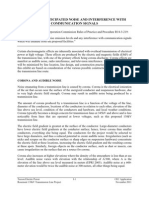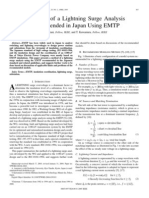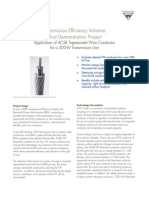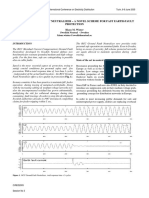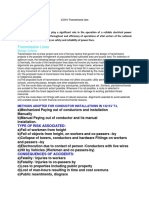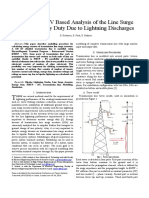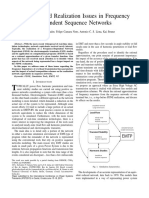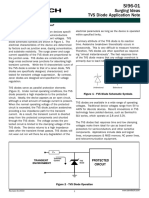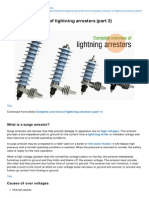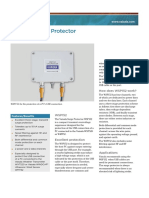Lightning Performance of Transmission
Uploaded by
Eleazar Sierra EspinozaLightning Performance of Transmission
Uploaded by
Eleazar Sierra EspinozaLightning Performance of Transmission Lines with
Tall Sections
A. J. G. Pinto, E. C. M. Costa, J. H. A. Monteiro, S. Kurokawa, J. Pissolato
AbstractAn analysis is proposed on the lightning
performance of non-homogeneous transmission line sections
composed of very-high tower structures. These line sections are
140 to 350 meter high and have been designed for transmission
lines in the South America and Asia. The proposed analysis is
carried out based on well-established modeling techniques for
transmission lines and towers, following the standards
established by the CIGRE and IEC to study lightning
performance of power transmission systems. Two transmission
line sections are considered: a conventional line with 40 meters
high and a non-conventional line section composed of towers with
more than 220 meters high (based on new transmission line
sections in the Amazon region in the Northern Brazil). The
lightning performance of both line sections are compared and an
alternative lightning protection is proposed using metal oxide
surge arresters connected directly at the towers.
Keywords: transmission lines; longitudinal impedance;
transversal admittance; parameter estimation; modal analysis.
I. INTRODUCTION
THIS
research proposes a discussion on the transient
behavior of transmission lines with non-homogeneous
sections composed of tower with 140 up to 350 meters high
which have been installed in the South America and Asia to
overcome natural and environmental barriers. In 2009, a
transmission line with similar structures was proposed for the
Tucuru-Manaus connection across the Amazon forest in the
Northern Brazil. The Tucuru-Manaus line is 1850 km length
and has several sections composed of towers with
approximately 200 meters high (fig. 1) [1, 2]. Several line
sections with tall structures have been constructed into the
Amazon forest, across long rivers and floodplain areas, which
represent a great challenge regarding the project itself and
logistic issues. Nevertheless, several technical issues require
an additional attention concerning insulation coordination,
variation of the line electrical parameters, grounding and
lightning surge protection.
This research was supported by Fundao de Amparo Pesquisa do Estado
de So Paulo FAPESP (Procs. 13/00974-5 and 14/00197-1).
E. C. M. Costa is with Universidade So Paulo, Escola Politcnica, Depto. de
Engenharia de Energia e Automao Eltricas PEA, So Paulo, SP, Brazil,
(corresponding author: ecmcosta@live.com).
S. Kurokawa is with Univ. Estadual Paulista - Unesp, Faculdade de
Engenharia de Ilha Solteira, Depto. de Engenharia Eltrica, SP, Brazil.
A. J. G. Pinto and J. Pissolato are with Universidade de Campinas, Faculdade
de Engenharia Eltrica, SP, Brazil.
J. H. A. Monteiro is with Universidade Federal do Acre, Centro de Cincias
Exatas e Tecnolgicas, Rio Branco, AC, Brazil.
Paper submitted to the International Conference on Power Systems
Transients (IPST2015) in Cavtat, Croatia June 15-18, 2015
Fig. 1. Transmission tower with 250 meters height into the Amazon forest.
The geometrical characteristics of the towers (height and
distance among wires) are intrinsically related to the
transversal and longitudinal parameters of the line, which
could result in significant variations on the propagation
characteristics of the line [3]. Another important characteristic
is the lack of a corridor in order to avoid major environmental
impacts. Despite several technical issues deserve a special
attention; this research analyzes electromagnetic transient
behavior and possible vulnerabilities in which the high line
sections are subject due to possible failures in the lightning
shield (grounding wires) and a possible major incidence of
lightning strokes because of the height of the metallic
structures.
This research evaluates two 440-kV line sections by
modeling using the Electromagnetic Transient Program EMTP [4]. The first system represents a conventional
transmission line with towers of approximately 40 meters
high. Second line section is composed of towers with 300
meters high, based on technical descriptions provided by an
international power company. The two line sections were
modeled using an EMTP and based on well-established
models described by the CIGRE and the IEEE [5, 6].
Simulations were carried out following the high-voltage and
lightning test standards provided by the IEC [7]. Two
situations were studied for each line section: with ZnO surge
arresters connected directly at the towers (line surge arresters)
and without the inclusion of surge arresters.
Significant variations on the transient performance of the
tall line section were observed and compared to the
conventional line with 40-m-high towers. Even including a
surge protection composed of 360-kV line surge arresters, the
transient voltage peaks on the non-conventional line are much
higher than expected [8]. These results lead to several
questions on the reliability of these non-conventional
transmission lines, if the tower models available in the
technical literature are also suitable to model transmission
towers with more than 140 meters high and if a conventional
surge protection apparatus (with 360-kV line surge arresters)
is also suitable for a 440-kV transmission line supported by
tall towers. The objective of this paper is to promote a
comprehensive technical discussion on the variations observed
in the electrical performance of the tall transmission section,
aiming a better understanding of these variations (compared to
the conventional 440-kV transmission line) as well as
development of alternative surge protection methods and
suitable computational models for this emergent power
transmission technology.
available in the EMTP. It is well-known that an atmospheric
impulse is composed of a wide range of frequencies; hence the
line modeling should take into account the frequency
dependence of the line parameters for the range of frequencies
which an atmospheric impulse is composed. Thus, the range
considered in the line modeling is up to 1 MHz. The
frequency-dependent line parameters are calculated
considering an ideal soil resistivity of 1000 .m [8].
The geometrical characteristics of the transmission line
sections are indicated in fig. 3 and given in the table 1.
II. METHODOLOGY
The proposed analyses are based on the accurate modeling
of the transmission line sections, towers, atmospheric impulse
and line surge arresters. These elements are modeled based on
well-established methods available in the technical
bibliography [3, 5, 6, 7]. From this methodology, the surge
voltage is simulated on the transmission tower where the
atmospheric impulse occurs, with and without the presence of
line surge arresters connected at the towers in parallel with the
insulator chains. Figure 2a shows an asymmetrical
transmission line equipped with line surge arresters,
highlighted by red circumferences, and in fig. 2b a line surge
is shown.
(a)
(b)
Fig. 2. Line surge arresters installed in a conventional asymmetrical tower (a)
and a line ZnO surge arrester described in details (b).
In fig. 2a, the line surge arresters are connected in parallel
with the line insulators. The superior terminal is connected to
the phase whereas the inferior terminal is wired to the metallic
structure of the tower. Figure 2b shows in details a line surge
arrester with an anti-corona ring at the superior terminal.
A. Transmission line modeling
The conventional and non-conventional line sections are
modeled using a frequency-dependent transmission line model
Fig. 3. Geometrical representation of the transmission line and tower.
TABLE I
GEOMETRICAL CHARACTERISTICS OF THE LINE SECTIONS
Conventional
Non-conventional
y1
y3
27.64 m
24.04 m
280 m
255 m
x23
yPR
18.54 m
36.0 m
24.0 m
300 m
xPR
15.02 m
12.0 m
The bundled conductors of both line sections have a
similar structure. They are composed of four Grosbeak
conductors spaced 0.4 m from each other. The shield wires are
EHWS-3/8 and implicitly included in the line modeling [9].
Another important technical description is the distance
between two consecutive towers, which is 500 m for the
conventional representation and 2 km for the line sections
using the tall towers (non-conventional) [8].
The frequency-domain behavior of the electrical
parameters of the non-conventional line section, described in
table I, are analyzed as a function of the soil resistivity in
reference [3] and [8].
B. Transmission line modeling
In computational models to study lightning performance of
transmission lines, the shield wires should be included as well
as towers and eventual nonlinear corona effect. Furthermore,
the necessary computational model should differ in
comparison with models applied for evaluation of
electromagnetic transient resulted from switching operations
in the systems [10]-[12]. The proposed phases and shield
wires are modeled as frequency-dependent line sections using
the mentioned computational line model. On the other hand,
the metallic structure of the towers is modeled by horizontal
and transversal transmission line sections, as described in
reference [5].
The horizontal sections of the towers are modeled as
horizontal transmission line where the parameters are obtained
from standard line formulas. The vertical sections are also
calculated using a specific formulation derived from the
standard line formulas. The mutual coupling between any two
parallel vertical transmission line sections is also taken into
account [5].
The transmission tower in fig. 3 is represented using
transmission line segments as follows in fig. 4.
Fig. 4. Transmission tower modeled by line segments.
Based on the proposed tower modeling, the
electromagnetic transient of each section can be expressed by
the well-known Transmission Line Telegrapher's Equations
[12]:
v( x, t )
i( x, t )
R( x)i( x, t ) L( x)
(1)
x
t
i( x, t )
v( x, t )
C( x)
(2)
x
t
The terms L(x), R(x) and C(x) are per unit-length
inductance, resistance and capacitance, respectively. The
equations (1) and (2) do not take into account the frequency
variations of the line parameters. However, since the skin
depth is very small at high frequencies, the approach presented
in [12] provides accurate results for fast and impulsive
transients. Equations (1) and (2) were originally obtained for
an infinite long line which means that end effects are
neglected. Thus, for the case of the shortest truss segments this
may not hold. Nevertheless, for the travel and the rise times of
the waveforms involved in lightning, tower arms behave as
long wires antennas. In this case, reflection analysis can be
performed considering only the transmission line behavior [6].
In reference [12], an interesting analysis is presented
comparing the modeling of tall towers using transmission line
and antenna theories. The same reference assumes that the
principal propagation mode is transverse electromagnetic
(TEM) and the voltage difference can be obtained between
any pair of points in the same transversal plane. Although the
TEM representation is an approximation, it provides a
practical method using the well-established transmission line
theory to model transmission towers. Furthermore, the
frequency- and time-domains analyses prior discussed in
reference [12], in which tower modeling using line and
antenna theories were compared, proves that the transmission
line representation is accurate enough to model towers to
study impulses with time to maximum up to 1 s (typical of
subsequent return strokes). Thus, assuming an atmospheric
impulse with a front-wave time of 2.6 s, the tall tower
modeling using transmission line theory shows to be
physically consistent.
C. Atmospheric impulse
The atmospheric impulse is modeled as a double
exponential current wave, characterized by a front time of 2.6
s and a tail time of 65 s. Usually, in agreement with the
International Electrotechnical Commission (IEC), a
normalized atmospheric impulse is represented by a 8/20 s
current wave [7]. However, a front-wave rise of 20 kA/s
(di/dt) given by a 2.6/65 s current wave has been widely used
to simulate atmospheric surges on transmission towers [3].
Furthermore, this wave shape represents a more conservative
situation because of the steeper front time, greater front-wave
rise and a longer tail time if compared to the IEC-normalized
atmospheric impulse [7].
The current source representing the atmospheric impulse is
applied at the top of a tower in the middle of the line length.
The transient voltage is measured on this same tower.
D. Surge arrester modeling
The first step to model surge arresters for a power
transmission system is to calculate the nominal voltage of the
arresters. This technical characteristic is obtained as a function
of the maximum system voltage and based on the temporary
overvoltage (TOV) capability at 60 Hz for 1 and 10 seconds.
For both 440-kV systems compared in this research, the
maximum operation voltage is 462 kV and the TOV
capabilities for 1 and 10 seconds are 1.4 p.u. and 1.25 p.u.,
respectively [13]. Based on these technical characteristics and
according with the information available in a given
manufacturer database, 360-kV ZnO surge arresters are
usually installed for nominal 440-kV systems with the given
maximum voltage operation and TOV. The tower surge
arresters used for the conventional and the non-conventional
lines are the same, since the nominal voltages of both systems
are the same.
The line surge arresters are modeled in the time domain
following the well-established IEEE reference model (fig. 5),
which is approached in several researches and technical
references in power system lightning protection [2, 9, 10].
Fig. 5. IEEE reference model for metal-oxide surge arresters.
The value of the elements L0, R0, L1, R1 and C are
calculated based on the number of varistor columns and the
physical height of the surge arrester. The magnitude of the
residual voltage from an atmospheric impulse (20 kA 8/20 s
current wave) and from a switching operation (2 kA 30/80 s
current wave) are necessary to calculate the nonlinear
resistances A0 and A1. The residual voltages of the 360-kV
surge arrester used in the current analysis are 856 kV for
atmospheric impulse and 712 kV for switching operation. The
L, R and C elements of the electric circuit in fig. 3 are obtained
based on the database provided by the manufacturer. More
details on modeling of surge arresters are given step-by-step in
reference [6].
The voltage profiles described in fig. 6 show an adequate
performance for a conventional 440-kV transmission system
equipped with 360-kV line surge arresters connected directly
at the towers. Curve 2 shows that the voltage surge is
maintained far below the maximum operation voltage of 462
kV. Otherwise, without the protection apparatus using line
surge arresters, the voltage peak is approximately 700 kV
(curve 1).
The same simulation is carried out considering the
geometrical and physical characteristics of the transmission
line section composed of towers with 300 meters high, as
described in table I. A 2.6/65 s current wave is applied at the
top of the metallic structure of a tower located at the middle of
an infinite line section. The transient voltages on the tall
tower, with and without the insertion of line surge arresters,
are shown in fig. 7.
III. ELECTROMAGNETIC TRANSIENTS AND SIMULATIONS
A conventional and a non-conventional infinite line
segment are considered according with the given descriptions
of the line, towers, wires and distance of two consecutive
towers. The surge impedance of the towers and the current
surge representing an atmospheric impulse are also previously
described. Based on these technical descriptions, the timedomain simulations are carried out from an atmospheric
impulse applied on a steel tower located at the middle of the
line segments. A critical and more conservative situation is
simulated, considering a total failure in the insulation
coordination
of
the
power
transmission
system
(backflashover). The transient overvoltages on the tower
struck by the atmospheric impulse are evaluated for the two
line sections, with and without the presence of line surge
arresters.
Figure 6 shows the transient voltages on the conventional
tower struck by the atmospheric impulse, without (curve 1)
and with line surge arresters at the three phases (curve 2).
Fig. 6. Transient voltages on the conventional tower without surge
arresters (1) and with line surge arresters (2).
Fig. 7. Transient voltages on the non-conventional tower without surge
arresters (1) and with line surge arresters (2).
For the non-conventional line section in fig. 7, the voltage
peak without line surge arresters is more than 1500 kV (curve
1), two times higher than the voltage peak observed in the
conventional system in fig. 5. Curve 2 shows that the 360-kV
ZnO arresters are not able to maintain the system voltage
below the maximum operational voltage of 462 kV, taking
into account that both transmission lines are characterized by
the same nominal voltage.
IV. DISCUSSION AND CONCLUSIONS
The two line sections compared in this research are based
on existing systems or transmission lines under construction,
as discussed in this paper and other technical literatures. Both
systems have the same operational voltage of 440 kV and
different geometrical and physical characteristics. However,
the lightning performance and the transient behavior of the
two line sections showed significant differences. Possible
causes and technical characteristics can be listed as follows:
i. Previous researches have described variations in the
transversal and longitudinal parameters of the conventional
and non-conventional line sections evaluated in this
research. Most of these variations were observed at high
frequencies which mean a direct influence on the lightning
performance observed for the non-conventional system.
ii. The distance of two consecutive towers of the nonconventional line section is approximately four times
longer than the same distance for the conventional line.
This characteristic results in a minor flow of shunt current
through the towers to the ground along the line. Each
tower is grounded at the base, thus the surge current has a
better surge current flow to the ground with a greater
number of towers per length. The quantity of tower per
length in the conventional line is greater than for the nonconventional one, consequently the conventional line
section has a better flow of the surge current through the
tower to the ground. By contrast, the line sections with
tower higher than 200 meters have a minor number of
tower per length which represents less flow of the surge
current wave to the ground and thus greater surge voltage
values at the tall towers.
iii. Variations on the surge inductances of the conventional
and non-conventional towers could result the major
transient voltage observed on the 300-m-high tower.
iv. The proposed tower modeling by line segments could not
be suitable for the non-conventional towers because of the
high height. The tower modeling using line segments is
suitable for conventional towers because they can be
represented by a set of short line segments, as discussed in
the paper. Otherwise, the tall towers are modeled by
several short and also long segments, which could not
represent an accurate approach for the non-conventional
towers.
v. An evaluation is necessary on the discharge channel of the
atmospheric impulse. The significant difference in the line
height of conventional and non-conventional towers may
result variations on the magnitude and wave shape of the
atmospheric impulse, resulting variations in the transient
behavior of the towers.
V. REFERENCES
[1]
[2]
[3]
[4]
[5]
[6]
[7]
[8]
[9]
[10]
[11]
[12]
[13]
G. N. D. Boile and R. L. Nascimento. "Linho Tucuru - 1800 km de
integrao regional", Revista T & D Amaznia, vol. 8, n. 18, pp.58-62,
2010 (Portuguese).
W. M. Frota. "Melhorias estruturais de suprimento para os sistemas
eltricos isolados de Manaus e Macap, Revista T & D Amaznia, vol. 3,
n. 6, pp.23-29, 2005 (Portuguese).
A. J. G. Pinto, E. C. M. Costa, S. Kurokawa, J. H. A. Monteiro, J. L.
Franco, J. Pissolato. Analysis of the electrical characteristics and surge
protection of EHV transmission lines supported by tall towers, Int.
Journal of Electrical Power & Energy Systems, vol. 57, pp. 358-365,
2014.
H. W. Dommel. EMTP theory book. University of British Columbia:
Vancouver, 1986.
Cigr Working Group 01 (Lightning) of Study Committee 33
(Overvoltages and insulation coordination): Guide to procedures for
estimating the lightning performance of transmission lines, 1991
C. A. Christodoulou, L. Ekonomou, G. P. Fotis, P. Karampelas, I. A.
Stathopulos. "Parameters' optimisation for surge arrester circuit models".
IET Science, Meas. & Technol., vol. 4, n. 2, pp. 86-92, 2010
IEC 60060-1. High-voltage test techniques - Part 1: general definitions
and test requirements, 2nd ed., 2009-2010
S. Kurokawa, E. C. M Costa, A. J. G. Pinto, J. Pissolato. Analysis of
electric characteristics of high-elevation stretches of the TucuruMacap-Manaus connection, Journal of Control, Automation and
Electrical Systems, vol. 24, pp. 714-724, 2013
S. Kurokawa, J. Pissolato, M. C. Tavares, C. M. Portela. Behavior of
overhead transmission line parameters on the presence of ground wires,
IEEE Trans. Power Delivery, vol. 20, n. 2, pp. 1669-1676, 2005.
W. A. Chisholm, Y. L. Chow, K. D. Srivastava. "Lightning surge
response of transmission towers". IEEE Trans. on Power App. and
Systems, vol. 102, n. 9, pp. 3232-3242, 1983.
J. A. Gutirrez, P. Moreno, J. L. Naredo, J. L. Bermdez, C. A. Nucci,
F. Rachidi. "Nonuniform transmission tower model for lightning
transient studies". IEEE Trans. on Power Delivery, vol. 19, n. 2, pp.
490-496, 2004.
L. Grcev, F. Rachidi. "On tower impedances for transient analysis".
IEEE Trans. on Power Delivery, vol. 19, n. 3, pp. 1238-1244, 2004.
IEC 60099-4. Surge arresters - Part 4: metal-oxide surge arresters
without gaps for a.c. systems, 2nd ed., 2004-2005.
You might also like
- RRU5258 Technical Specifications (V100R015C10 - 01) (PDF) - EN100% (1)RRU5258 Technical Specifications (V100R015C10 - 01) (PDF) - EN42 pages
- Exhibit I Anticipated Noise and Interference With Communication SignalsNo ratings yetExhibit I Anticipated Noise and Interference With Communication Signals4 pages
- Simulation of Some Power System, Control System and Power Electronics Case Studies Using Matlab and PowerWorld SimulatorFrom EverandSimulation of Some Power System, Control System and Power Electronics Case Studies Using Matlab and PowerWorld SimulatorNo ratings yet
- Lightning Performance of EHV and UHV OverheadNo ratings yetLightning Performance of EHV and UHV Overhead6 pages
- Reduction of Flashovers On 220 KV Double-Circuits LineNo ratings yetReduction of Flashovers On 220 KV Double-Circuits Line6 pages
- Lightning Performance of 275 KV Transmission LinesNo ratings yetLightning Performance of 275 KV Transmission Lines5 pages
- Monitoring of Overhead Transmission Lines: A Review From The Perspective of Contactless TechnologiesNo ratings yetMonitoring of Overhead Transmission Lines: A Review From The Perspective of Contactless Technologies18 pages
- Identification of Problems When Using Long High VoNo ratings yetIdentification of Problems When Using Long High Vo8 pages
- Lightning Simulation of A Combined Overhead Line Cable Connected GISNo ratings yetLightning Simulation of A Combined Overhead Line Cable Connected GIS15 pages
- Calculation of Lightning-Induced OvervoltagesNo ratings yetCalculation of Lightning-Induced Overvoltages7 pages
- A Method of A Lightning Surge Analysis Recommended in Japan Using EMTPNo ratings yetA Method of A Lightning Surge Analysis Recommended in Japan Using EMTP9 pages
- Study of Uprating Planning Overheard Transmission Line 70 KV To Be 150 KV GI Bangil - GI Blimbing LineNo ratings yetStudy of Uprating Planning Overheard Transmission Line 70 KV To Be 150 KV GI Bangil - GI Blimbing Line11 pages
- Lightning Protection of Transmission Lines: Optimal ShieldingNo ratings yetLightning Protection of Transmission Lines: Optimal Shielding9 pages
- Lightning Performance of Cmpact Lines PDFNo ratings yetLightning Performance of Cmpact Lines PDF20 pages
- A Practical Approach For Determining The Grounding Grid PDFNo ratings yetA Practical Approach For Determining The Grounding Grid PDF6 pages
- Measured Result: y E-Field Cell E-Field CellNo ratings yetMeasured Result: y E-Field Cell E-Field Cell7 pages
- Development of 765 KV AC Transmission KEPCONo ratings yetDevelopment of 765 KV AC Transmission KEPCO4 pages
- Optimal Design of Overhead Transmission-927No ratings yetOptimal Design of Overhead Transmission-92712 pages
- Design and Operation of EHV Transmission LinesNo ratings yetDesign and Operation of EHV Transmission Lines10 pages
- Simulation of Transients With A Modal-DomainNo ratings yetSimulation of Transients With A Modal-Domain8 pages
- Failure of The Collection Volume MethodNo ratings yetFailure of The Collection Volume Method10 pages
- 400KV Lattice Steel Tower Design Requirements and Design Spans For Support Locations PDFNo ratings yet400KV Lattice Steel Tower Design Requirements and Design Spans For Support Locations PDF7 pages
- 33-04 - 1968 Design of OHTL For Better Lightning PerformanceNo ratings yet33-04 - 1968 Design of OHTL For Better Lightning Performance12 pages
- Improved Three-Phase Power-Flow Methods Using Sequence Components - MA Akher - KM Nor - AHA RashidNo ratings yetImproved Three-Phase Power-Flow Methods Using Sequence Components - MA Akher - KM Nor - AHA Rashid13 pages
- On-Line Estimation of Transmission Line Parameters, Temperature and Sag Using PMU MeasurementsNo ratings yetOn-Line Estimation of Transmission Line Parameters, Temperature and Sag Using PMU Measurements7 pages
- AESO Section 502.2 Bulk Transmission Line Technical Requirements AmendmentNo ratings yetAESO Section 502.2 Bulk Transmission Line Technical Requirements Amendment17 pages
- Some Aspects of System Modelling For The Estimation of Lightning Performance of High Voltage SubstationsNo ratings yetSome Aspects of System Modelling For The Estimation of Lightning Performance of High Voltage Substations6 pages
- 10 Application of ACSR Trapezoidal Wire Conductor For A 500-KV Transmission Line100% (1)10 Application of ACSR Trapezoidal Wire Conductor For A 500-KV Transmission Line2 pages
- William H. Kersting-Distribution System Modeling and Analysis (Electric Power Engineering Series) - CRC Press (2001)0% (1)William H. Kersting-Distribution System Modeling and Analysis (Electric Power Engineering Series) - CRC Press (2001)20 pages
- Lfa (Lightning Frequency Arrester) For Merge100% (1)Lfa (Lightning Frequency Arrester) For Merge36 pages
- Optimisation of Power Cable Ampacity in Offshore WNo ratings yetOptimisation of Power Cable Ampacity in Offshore W10 pages
- FEM Situation - A Thermal Model For Three-Core Armored Submarine CNo ratings yetFEM Situation - A Thermal Model For Three-Core Armored Submarine C19 pages
- Analysis For Power System State EstimationNo ratings yetAnalysis For Power System State Estimation9 pages
- PTEC - 500 - Fundamentals of Overhead Transmission Line DesignNo ratings yetPTEC - 500 - Fundamentals of Overhead Transmission Line Design2 pages
- Modeling of Photovoltaic Systems Using MATLAB: Simplified Green CodesFrom EverandModeling of Photovoltaic Systems Using MATLAB: Simplified Green CodesNo ratings yet
- Markov Chains (Part 3) : State ClassificationNo ratings yetMarkov Chains (Part 3) : State Classification19 pages
- Continuous-Time Systems: Dept. of Electrical and Computer Engineering The University of Texas at AustinNo ratings yetContinuous-Time Systems: Dept. of Electrical and Computer Engineering The University of Texas at Austin24 pages
- Single-Pole Operation Leads To HazardousNo ratings yetSingle-Pole Operation Leads To Hazardous12 pages
- An EMTP - RV Based Analysis of The Line SurgeNo ratings yetAn EMTP - RV Based Analysis of The Line Surge6 pages
- Synchrophasors For Validation of DistanceNo ratings yetSynchrophasors For Validation of Distance8 pages
- Accuracy and Realization Issues in FrequencyNo ratings yetAccuracy and Realization Issues in Frequency7 pages
- 26071-100-V1a-J001-20407 - 000 Sis System Cabinet Arrangement For Ish-104No ratings yet26071-100-V1a-J001-20407 - 000 Sis System Cabinet Arrangement For Ish-10410 pages
- Surge Protection Made As Simple As A Circuit BreakerNo ratings yetSurge Protection Made As Simple As A Circuit Breaker8 pages
- DC1S-48-S: DC Surge Suppression SolutionNo ratings yetDC1S-48-S: DC Surge Suppression Solution2 pages
- Complete Overview of Lightning Arresters Part 2No ratings yetComplete Overview of Lightning Arresters Part 25 pages
- RRU3281 Technical Specifications (V100R017C10 - 01) (PDF) - ENNo ratings yetRRU3281 Technical Specifications (V100R017C10 - 01) (PDF) - EN13 pages
- Railway Signalling: Surge Protection For Railway SystemsNo ratings yetRailway Signalling: Surge Protection For Railway Systems22 pages
- Lightning Protection Risk Management: Date: 4/12/2020 Project No.: 12/008No ratings yetLightning Protection Risk Management: Date: 4/12/2020 Project No.: 12/00815 pages
- The ABC's of Lightning: To Be Sure, Use DehnNo ratings yetThe ABC's of Lightning: To Be Sure, Use Dehn12 pages
- RRU5258 Technical Specifications (V100R015C10 - 01) (PDF) - ENRRU5258 Technical Specifications (V100R015C10 - 01) (PDF) - EN
- Exhibit I Anticipated Noise and Interference With Communication SignalsExhibit I Anticipated Noise and Interference With Communication Signals
- Simulation of Some Power System, Control System and Power Electronics Case Studies Using Matlab and PowerWorld SimulatorFrom EverandSimulation of Some Power System, Control System and Power Electronics Case Studies Using Matlab and PowerWorld Simulator
- Reduction of Flashovers On 220 KV Double-Circuits LineReduction of Flashovers On 220 KV Double-Circuits Line
- Lightning Performance of 275 KV Transmission LinesLightning Performance of 275 KV Transmission Lines
- Monitoring of Overhead Transmission Lines: A Review From The Perspective of Contactless TechnologiesMonitoring of Overhead Transmission Lines: A Review From The Perspective of Contactless Technologies
- Identification of Problems When Using Long High VoIdentification of Problems When Using Long High Vo
- Lightning Simulation of A Combined Overhead Line Cable Connected GISLightning Simulation of A Combined Overhead Line Cable Connected GIS
- A Method of A Lightning Surge Analysis Recommended in Japan Using EMTPA Method of A Lightning Surge Analysis Recommended in Japan Using EMTP
- Study of Uprating Planning Overheard Transmission Line 70 KV To Be 150 KV GI Bangil - GI Blimbing LineStudy of Uprating Planning Overheard Transmission Line 70 KV To Be 150 KV GI Bangil - GI Blimbing Line
- Lightning Protection of Transmission Lines: Optimal ShieldingLightning Protection of Transmission Lines: Optimal Shielding
- A Practical Approach For Determining The Grounding Grid PDFA Practical Approach For Determining The Grounding Grid PDF
- 400KV Lattice Steel Tower Design Requirements and Design Spans For Support Locations PDF400KV Lattice Steel Tower Design Requirements and Design Spans For Support Locations PDF
- 33-04 - 1968 Design of OHTL For Better Lightning Performance33-04 - 1968 Design of OHTL For Better Lightning Performance
- Improved Three-Phase Power-Flow Methods Using Sequence Components - MA Akher - KM Nor - AHA RashidImproved Three-Phase Power-Flow Methods Using Sequence Components - MA Akher - KM Nor - AHA Rashid
- On-Line Estimation of Transmission Line Parameters, Temperature and Sag Using PMU MeasurementsOn-Line Estimation of Transmission Line Parameters, Temperature and Sag Using PMU Measurements
- AESO Section 502.2 Bulk Transmission Line Technical Requirements AmendmentAESO Section 502.2 Bulk Transmission Line Technical Requirements Amendment
- Some Aspects of System Modelling For The Estimation of Lightning Performance of High Voltage SubstationsSome Aspects of System Modelling For The Estimation of Lightning Performance of High Voltage Substations
- 10 Application of ACSR Trapezoidal Wire Conductor For A 500-KV Transmission Line10 Application of ACSR Trapezoidal Wire Conductor For A 500-KV Transmission Line
- William H. Kersting-Distribution System Modeling and Analysis (Electric Power Engineering Series) - CRC Press (2001)William H. Kersting-Distribution System Modeling and Analysis (Electric Power Engineering Series) - CRC Press (2001)
- Optimisation of Power Cable Ampacity in Offshore WOptimisation of Power Cable Ampacity in Offshore W
- FEM Situation - A Thermal Model For Three-Core Armored Submarine CFEM Situation - A Thermal Model For Three-Core Armored Submarine C
- PTEC - 500 - Fundamentals of Overhead Transmission Line DesignPTEC - 500 - Fundamentals of Overhead Transmission Line Design
- Power System Wide-area Stability Analysis and ControlFrom EverandPower System Wide-area Stability Analysis and Control
- Modeling of Photovoltaic Systems Using MATLAB: Simplified Green CodesFrom EverandModeling of Photovoltaic Systems Using MATLAB: Simplified Green Codes
- Continuous-Time Systems: Dept. of Electrical and Computer Engineering The University of Texas at AustinContinuous-Time Systems: Dept. of Electrical and Computer Engineering The University of Texas at Austin
- 26071-100-V1a-J001-20407 - 000 Sis System Cabinet Arrangement For Ish-10426071-100-V1a-J001-20407 - 000 Sis System Cabinet Arrangement For Ish-104
- Surge Protection Made As Simple As A Circuit BreakerSurge Protection Made As Simple As A Circuit Breaker
- RRU3281 Technical Specifications (V100R017C10 - 01) (PDF) - ENRRU3281 Technical Specifications (V100R017C10 - 01) (PDF) - EN
- Railway Signalling: Surge Protection For Railway SystemsRailway Signalling: Surge Protection For Railway Systems
- Lightning Protection Risk Management: Date: 4/12/2020 Project No.: 12/008Lightning Protection Risk Management: Date: 4/12/2020 Project No.: 12/008



